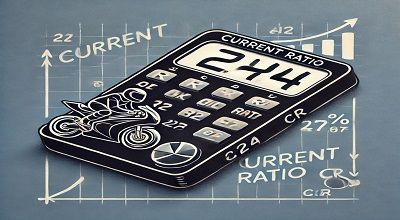Current Ratio: A Key Metric in Financial Analysis
In financial analysis, the current ratio serves as a vital tool for assessing a company’s short-term liquidity and its ability to meet immediate financial obligations. Comprehending this ratio involves understanding its formula, significance, and how it influences decision-making within organizations and among stakeholders.
Formula:
The current ratio is calculated by dividing a company’s current assets by its current liabilities. Mathematically, it is represented as follows:

Definition:
The current ratio, often termed the working capital ratio, indicates a company’s capability to cover its short-term liabilities with its short-term assets. Current assets encompass cash, marketable securities, accounts receivable, and inventory, which can be readily converted into cash within a year. Conversely, current liabilities include obligations that are due within the same period. Such as accounts payable, short-term debt, and accrued expenses.
Interpretation:
A current ratio greater than 1 suggests that a company possesses more current assets than current liabilities, implying a healthy liquidity position. It implies that the company has the potential to fulfill its short-term obligations without facing significant liquidity issues. However, an excessively high ratio may indicate underutilized assets, inefficiency in resource allocation, or an inadequate investment strategy.
Conversely, a (CR) below 1 signifies that a company may struggle to meet its short-term obligations with its existing current assets. This scenario could raise concerns about the entity’s liquidity risk and its ability to manage financial commitments effectively. Nevertheless, a low (CR) isn’t always detrimental; it might simply indicate that the company is efficiently utilizing its resources to generate revenue or reinvest in long-term growth opportunities.
Importance in Decision-Making:
The current ratio holds significance for various stakeholders, including investors, creditors, and management:
- Investors: Investors utilize the current ratio as part of their fundamental analysis to gauge a company’s financial health and its capacity to weather short-term economic fluctuations. A strong (CR) often instills confidence among investors regarding the company’s stability and resilience.
- Creditors: Creditors, such as banks and suppliers, assess the current ratios to evaluate the likelihood of repayment. A higher ratio reassures creditors about the company’s ability to honor its debts, potentially leading to more favorable credit terms.
- Management: For management, monitoring the current ratios aids in strategic decision-making and operational planning. It provides insights into the efficiency of working capital management. Guides adjustments in inventory levels, credit policies, and capital allocation strategies.
Conclusion
In essence, the current ratio serves as a fundamental metric in financial analysis. Offering valuable insights into a company’s liquidity position and influencing strategic decisions across various stakeholders. Understanding its implications enables informed decision-making and fosters financial stability within organizations.
